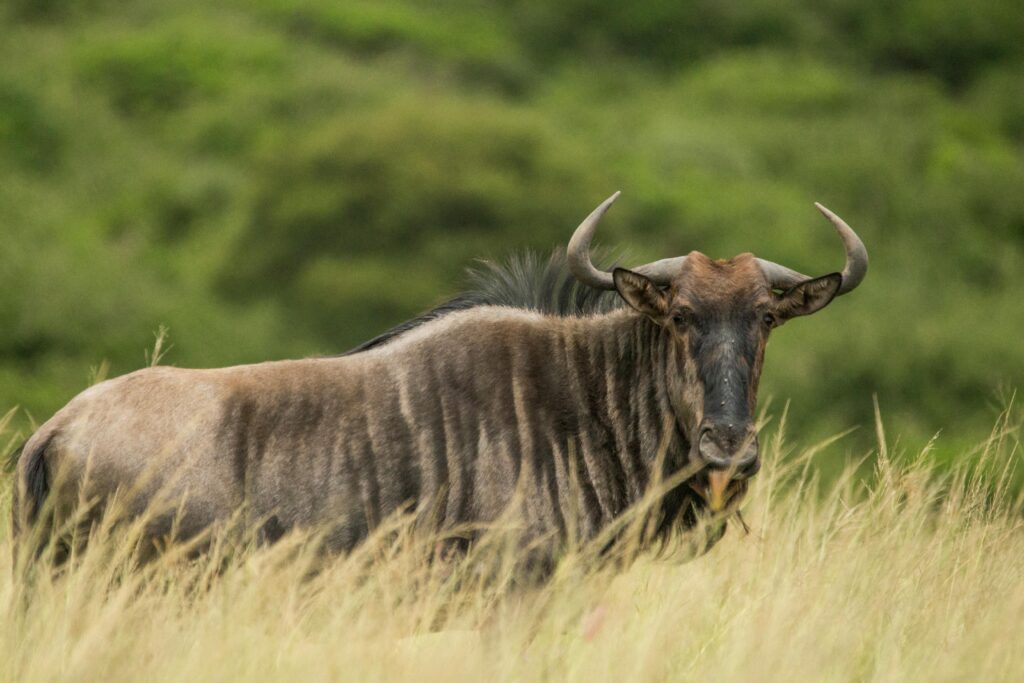A study published in Palaeogeography, Palaeoclimatology, Palaeoecology challenges long-held assumptions about the habitat preferences of wildebeests and other African mammals, with implications for both paleoenvironmental reconstructions and evolutionary models.
The research, led by Kathryn Sokolowski of the University of Utah, used large-scale surveys and satellite imagery to demonstrate that many African mammals, including wildebeests, are not as habitat-specific as previously believed. This insight redefines how researchers interpret the connection between fossils, ancient landscapes, and the evolution of species, including hominins.
1. Wildebeest and Mammalian Habitat Preferences:
- The study’s data reveals that most African mammals are found in environments with around 50% woody cover, meaning they inhabit a mix of open grasslands and forests. This is contrary to the conventional view that wildebeests strictly prefer open grasslands.
- Only a few species were strongly associated with environments that had less than 30% woody cover (open grasslands) or more than 70% woody cover (dense forests).
- Wildebeests, zebras, and other herbivores show adaptability and flexibility, inhabiting a variety of landscapes, which include mixed environments rather than sticking to strictly open grasslands.
2. Questioning the Validity of Fossils in Reconstructing Ancient Landscapes:
- The study suggests that fossils, traditionally used as indicators of specific ancient environments (e.g., grasslands for wildebeests), may not provide an accurate depiction of historical landscapes.
- Paleoenvironmental reconstructions that rely on fossils often present a mosaic pattern, which draws sharp boundaries between different environments, such as separating grassy plains from wooded areas. However, the findings of this study indicate that such demarcations might oversimplify the actual diversity and blending of habitats that wildebeests and other species experienced.
- Fossil evidence used to identify grasslands may need to be reevaluated, as the current study shows that species like wildebeests can occupy a wide range of habitats.
3. Role of Woody Cover in Animal Distribution:
- The research found that many species, including wildebeests, inhabit areas with a moderate amount of woody cover. This suggests that savannas, which provide both grass for grazers and trees for browsers, are the preferred habitat for many animals.
- The study contradicts the assumption that certain herbivores exclusively live in either open plains or dense forests. Instead, the findings point to a more complex relationship where species coexist in mixed environments, highlighting the heterogeneity of African landscapes.
4. Implications for Grassland Evolution and Species Survival:
- The expansion of C4 plants (a type of grass adapted to hot, arid conditions) during the last 10 million years is considered one of the major ecological changes in Africa. The development of these grasslands was long thought to have driven the evolutionary paths of species, including hominins (early humans). However, this study suggests that habitat flexibility among grazers like wildebeests may mean that grassland expansion wasn’t as impactful on species evolution as previously believed.
- This finding challenges the prevailing theory that species’ survival depended solely on their ability to adapt to specific landscape changes, such as the shift from forests to grasslands.
5. Significance of Large-Scale Habitat Surveys:
- By using large-scale surveys across 123 national parks and game reserves in sub-Saharan Africa, the study provides a broader and more accurate view of the habitat preferences of African mammals.
- Previous studies may have relied on smaller, isolated surveys that failed to capture the complexity of mammal distribution across Africa’s diverse ecosystems. The scale of this study shows that species’ preferences for certain habitats may have been overestimated in the past.
6. Impacts on Human Evolution Studies:
- The study has significant implications for anthropologists studying human evolution. The expansion of grasslands has long been linked to key milestones in human history, such as the development of stone tools and the emergence of new hominin species. However, this new research calls into question the role that environmental changes, particularly the shift to grasslands, played in shaping early human evolution.
7. Revising Ecological and Evolutionary Assumptions:
- The study’s findings suggest that many of the assumptions used in ecological and evolutionary models should be revisited. John Rowan, an anthropologist at the University of Albany, points out that the study provides a novel perspective by showing that many mammal species long thought to be habitat-specific indicators are actually more habitat-flexible than previously assumed.
- This flexibility means that widespread environmental changes like grassland expansion may not have been as significant a driver of speciation or extinction as once thought.
Conclusion:
The research calls for a rethinking of the relationship between mammal species and their habitats. The study reveals that species like wildebeests are not bound to strict habitat types, challenging the use of fossils as indicators of ancient environments. It also raises important questions about how large-scale environmental changes in the past have influenced evolution, including the development of early humans. The key takeaway is that African landscapes and the species that inhabit them are much more dynamic and flexible than previously understood, necessitating a broader and more nuanced approach to studying the link between environment and evolution.

